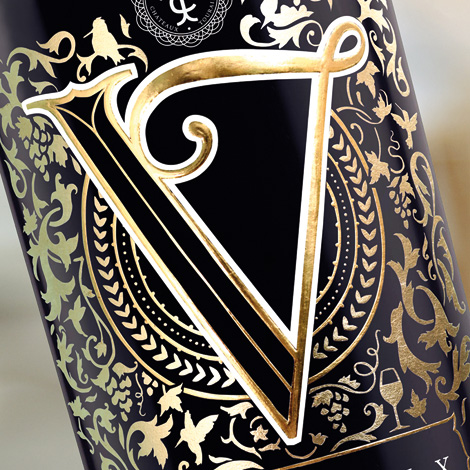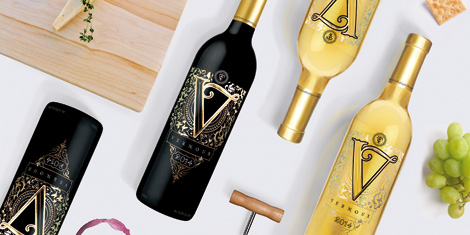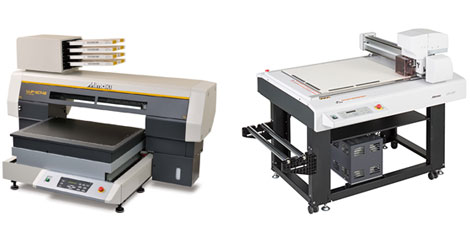Andy Spreag from i-Sub Digital considers the use of metallic foiling effects in packaging and how digital technology can make the proofing process quicker and more cost effective than traditional methods.
Christmas is on the retail horizon and the shelves are preparing to shine with the golds and silvers of festive packaging. Adding metallics to a product gives a taste of luxury while, importantly, the reflected light helps it to stand out amongst its competitors.
“Gold has this glorious quality, an opulent and alluring quality,” says Andrew Novialdi, a designer based in Indonesia who often uses metallic elements in his designs, chiefly gold. “It gives a radiance to a product, a divine status.” Novialdi works in food packaging design, in addition to corporate branding, posters, wedding products and other work complementary to his intricate work influenced by illuminated religious manuscripts.
A Traditional Approach
Andrew Novialdi employs the traditional hot foiling method for his design prototypes. The first stage is to produce a vector file, which is turned into a film via graphic software such as Adobe Illustrator. The film is placed on a polymer material or metal such as magnesium and exposed to UV light, with acid added to produce the design in relief, creating a plate (also called a die or stamp). Next comes the tricky step of mounting the plate onto the hot foil machine: it must be fitted accurately so it lands exactly where the design should be on the media. The metallic foil is sandwiched between the hot plate and the media; when the machine presses the layers together the impression of the design will be left on the paper in foil. The results are eye-catching gold effects that turn a beautiful package design into a completed prototype worthy of catching any customer’s eye.
The process typically takes around two weeks from first design to signed-off prototype. Novialdi outsources printing work and says the turnaround time, cost and the quality can vary from business to business, while the comparatively small size of a standard foiling machine can also limit designs, but it is a process that produces stunning results.

The stunning gold leaf work above is the creation of packaging designer Andrew Novialdi, using traditional methods, but can digital technology make this production easier and more cost effective? www.andrewnovialdi.com
A Digital Future?
Digital systems are being developed to enhance and improve these traditional methods. Digi-Foil, for instance, is i-Sub Digital’s solution that uses a digital desktop printer from manufacturer Mimaki to lay down a design in primer to which foil material can be adhered, before being fixed with a heated applicator. It can also be combined with a small-format digital cutting and creasing unit such as the Mimaki CFL-605RT to create a full package prototype, using the same foil and substrate as the finished product, in just a few minutes from the first design. This can be altered, dramatically if necessary, and quickly printed, cut and folded again.
Andrew Novialdi usually gives his clients three design options of which one plate is normally made, but it is only at the end of the lengthy die-making and foiling process that he and his client can see the proof in its opulent golden glory. If changes are required, a new die must be made and foiling done again. With a digital system, designers and their clients can mull over any number of packaging possibilities, all finished in accurate shapes and colours, in a single afternoon; indeed, several foil options can be completed at once for immediate comparison.
“A digital system is certainly exciting,” says the designer. “It means producing prototypes more cheaply and more quickly.” He adds that a solution like Digi-Foil can be also used to output just one or two foiled designs at a time, while outsourcing the work to a litho printer would mean committing to a minimum run length of hundreds. “The minimum charge is the downfall of traditional printing processes,” says Novialdi.
Digital proofing systems, both printers and cutters, are designed to pack efficiency and flexibility into a compact footprint and small price tag; a Mimaki CFL605 cutter and Digi-Foil solution with a Mimaki UJF UV printer can be purchased together for around £25,000, within reach of design agencies wishing to bring proofing work in house or other graphics businesses looking to diversify. The Mimaki UJF printer can also be fitted with an optional attachment, the Kebab, which enables printing directly onto cylindrical items such as bottles and tubes. Digi-Foil can also be utilised using the Kebab system which offers unlimited opportunity for cylindrical applications.
Always Time to Shine
Christmas aside, packaging featuring reflective metallic details in gold, silver – or any of the hundreds of other colours, shades and patterns of foil – can bring a certain style to any package at any time. It can be luxurious or extravagant, bring a hint of divinity to a product, or beautifully highlight simple details, but always makes it special. The processes to achieve it are varied, but as technology develops designers and their clients have more options than ever to bring their ideas to glittering life.
To find out more about the digital package proofing solutions available from Mimaki, contact i-Sub Digital on Tel: 01536 415511 or visit their website.
Produce foil effects digitally, and then cut them to shape, for perfect packaging proofs – all produced on Mimaki hardware.



